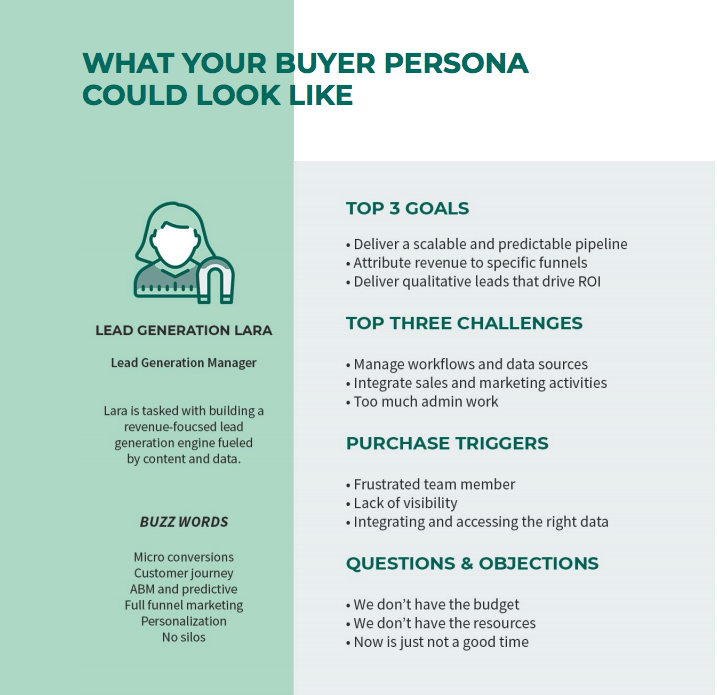
A successful lead generation campaign, regardless of marketing strategy, starts with defining your potential buyer. The reason for defining your potential buyer is simple: it will help your marketing and boosts your sales. Why? Because your sales are likely to increase if you know who you are selling to. The creation of different personas will make it easier to launch well-structured campaigns with targeted communication so – when done right – the effects of buyer personas can be significant.
But let's start from the beginning.
What's a buyer persona?
Before we go on with how to create a buyer persona, we first need to establish what they actually are. The short answer is that buyer personas are fictional characters used to humanize and understand particular audience segments.
Defining your buyer personas isn’t an easy task. It requires both time and effort. Personas should always be based on research, statistics, and experiences, as well as some rough estimations. To refine your buyer personas, it’s a good idea to complete your research by interviewing some of your current customers.
As with all marketing strategies, it’s important to remember that the work doesn’t stop once your personas are in place. Just like your business grows and evolves – so should your buyer personas. Consequently, you need to make sure your buyer personas are updated and maintained over time.
Buyer personas can look different, there is no correct answer on how they should be presented. But below we have listed a simple example of how it could be outlined.
The differences between a B2C and a B2B buyer persona
Buyer personas are useful in both B2B and B2C. However, there are a few differences as to how they are used and created. Below, we have listed the differences between a B2C and a B2B buyer persona.
B2B
- Collective decisions as a company, weighing out the pros and cons of the available solutions
- Rely on value-driven, educational content to help make decisions
- Need to establish trust and credibility before purchase
- No impulse purchases
B2C
- Purchases are typically based on an individual decision
- Purchases are more emotive and less logical
- Make purchases based on their own perceptions, wants, and needs
- Purchases can be impulsive
Your 6-step guide to creating B2B Buyer Personas
In order to maximize your marketing reach and create successful lead generation strategies, you have to get to know your potential customers beyond just demographics. We have put together a six-step process to get you started!
1. ROLE IN THE BUYING PROCESS
Who has the most influencing and purchasing power? This often comes down to C-level roles at bigger companies, but you also need to take into account the people that will influence that decision.
Ask this:
- What job titles do they have?
- What are their daily responsibilities?
- Who do they report to?
- Who reports to them?
- What’s their career background and career path?
2. FEARS AND CHALLENGES
By identifying your buyer persona’s fears and challenges you can develop more targeted messaging. Essentially, you want to find out what keeps them up at night.
Ask this:
- What’s a daily cause of stress for them at work?
- What challenges does your product help eliminate?
- Why would they not want to buy your product?
- What important problem does your product solve for them?
3. DRIVERS AND MOTIVATORS
To understand your buyer persona, we need to know what motivates them as well as the company.
Ask this:
- What is the company or person trying to achieve?
- Could our product help this person perform better in their job?
- Does our product help them get to where they want to go?
4. ORGANIZATIONAL GOALS AND PRIORITIES
Understanding overall company goals and how your product can help the company reach those goals is essential in the buying process.
Ask this:
- What are their individual and team goals?
- How are goals measured?
- What targets do they need to meet?
- What problems are they trying to solve?
5. PROBLEMS AND ISSUES
Your product or solution has to actually solve a problem that they have. This is the key factor that will drive the buying process forward.
Ask this:
- How are they currently doing business?
- What systems do they have in place?
- Which of our competitors are they using?
- How can we make their job easier?
6. ONLINE BEHAVIOR
If you plan on launching a digital inbound campaign you need to know where your buyer personas spend time in order to reach them and target them correctly.
Ask this:
- What type of content does your buyer search for?
- How does your buyer persona consume content?
- Where do they spend time online?
How many buyer personas should you create?
As a general rule, you should consider creating between three and five personas for your B2B company. But of course it depends on your target group and needs.
Good luck with your personas! Please reach out if you need help creating them or if you want to discuss how we can help you generate more leads using inbound marketing. Or learn more about buyer personas and lead generation for B2B tech companies in our massive eBook “LEAD GENERATION FOR B2B TECH COMPANIES”


